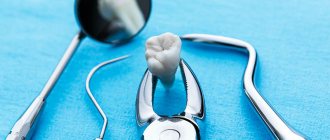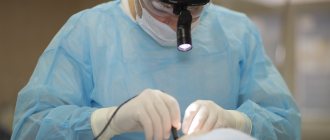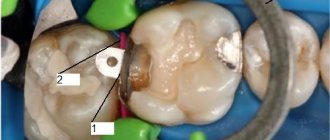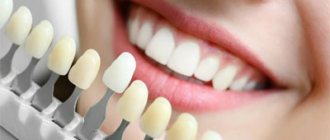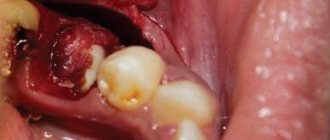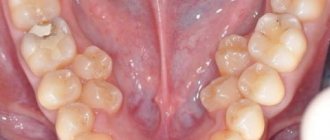How to understand that a tooth can be removed
Baby teeth begin to loosen at about 5-7 years of age.
A loose tooth can cause a lot of trouble for a child. The difficulties are mainly related to eating. With a loose tooth, it is difficult to eat solid foods, for example, raw fruits, vegetables, crackers, etc. Sooner or later, the baby tooth will fall out as it is replaced by a permanent tooth. Many people force this process, since a loose baby tooth is a source of discomfort in the oral cavity, which they want to get rid of as soon as possible. But how to pull out a tooth at home, and is it worth doing it yourself? A reasonable solution to this issue is to consult a doctor. But in practice, few people go to dentistry to remove a baby tooth. Therefore, if you decide to remove a child’s tooth yourself, then make sure it can be done.
First, examine the child's oral cavity using artificial light. Make sure there is no swelling in your mouth and your gums are a healthy pink color. Also make sure that the child does not have caries or other dental diseases, chips or cracks. If you find any, consult a doctor and give up the idea of removing them yourself.
The most important condition for removing a baby tooth is its mobility. If it wobbles slightly, then it’s too early to tear it. You can remove it when it is very loose. When you wiggle your fingers, you should be left with the impression that the tooth is being held on by one string. If the range of movements is insufficient, then persuade the child to be patient until the right moment arrives.
Care instructions
Before the socket is tightened, you should not overheat the body, drink or eat hot or cold drinks, food, or chew on the operated side. You should not smoke, as nicotine constricts blood vessels and impairs wound healing. It is forbidden to lick a blood clot from the socket.
Antibiotics are prescribed for tooth extraction if the procedure was complicated. They are necessary to prevent tissue infection and the development of inflammatory processes. For the same reason, it is recommended to rinse your mouth with antiseptics. In this case, there is no need to rinse intensively, since it is possible to wash out the blood clot from the socket. Analgesics can be used to relieve pain.
Is it appropriate to rush to remove baby teeth?
The baby tooth falls out as it is replaced by a permanent one. When it comes out, the latter puts pressure on the base of the baby tooth, which leads to its loss. This process takes about a week. At the first stage, the ligaments that hold the tooth in the socket become thinner. In most cases, this process is painless. The range of mobility increases day by day until the tooth falls out on its own.
Dentists recommend not to rush into removing baby teeth. You should not interfere with the natural process laid down by evolution. There are four reasons why rushing to remove a baby tooth is not advisable:
- The baby tooth acts as a barrier to oral microorganisms . Thus, it protects soft tissues from bacterial infection. In addition, when removed there is a risk of microorganisms entering the bloodstream.
- Formation of the correct bite . If baby teeth are removed incorrectly, the risk of developing a malocclusion increases. When physiological processes occur in a timely manner (including the appearance of molars), the likelihood of developing a defective bite is reduced. Think about this if you are concerned about how to pull out a baby tooth at home.
- Fear of the dentist . The child will have to go to the dentist in the future. If the removal is accompanied by anxiety and fear, then in the future the child will experience anxiety before visiting the dentist.
- Overgrowth of gums. If the baby tooth has not yet fallen out, this indicates that the process needs additional time. This means that the tissues are not yet ready to replace a baby tooth with a permanent one. As soon as a baby tooth falls out, a permanent tooth immediately appears in its place. And if a baby tooth is removed too early, the gums will overgrow during this time. In this case, the permanent one will have to break through the overgrown gum.
As you can see, the rush to delete is often inappropriate. If you have any doubts about this, consult your doctor.
Stages of the procedure
Simple extirpation is carried out using forceps, consisting of cheeks, a handle, and a lock. It is performed if the coronal part is well preserved and there are no various complications. Incisors and canines on the upper jaw are removed with straight forceps, on the lower jaw - curved at an angle of 90 degrees. S-shaped instruments are used to extract premolars and molars.
Removing an upper wisdom tooth is easier than on the lower jaw, since it has an even, small root, so a simple operation is performed if there are no complications. The lower jaw bone is denser and more massive, and the root part of the figure eight is complex.
A simple extraction consists of several steps:
- local anesthesia;
- antiseptic treatment;
- application of forceps followed by advancement of the cheeks under the gums and fixation;
- rocking, dislocation and extraction of a dental unit from the socket.
Complex extirpation requires the use of several different instruments, takes a longer time, injures nearby tissues, is dangerous for complications, and the rehabilitation process lasts longer. Pain relief during tooth extraction, especially eights, can be general. The surgeon uses a scalpel or laser, drill, elevator, excavator, and other instruments.
Step-by-step complex removal:
- local or general anesthesia;
- antiseptic treatment;
- dissection of the gums, separation of the flap from dental and bone tissues;
- if necessary, drilling or cutting off part of the bone, dividing the root into several fragments;
- extraction of a dental unit in whole or in parts;
- bleeding stop;
- application of antibacterial and anti-inflammatory drugs;
- suturing the gum.
To stitch soft tissues, self-absorbing or non-absorbable threads are used, which are removed after 7-10 days.
Is it possible to remove baby teeth yourself?
In most cases, children cope with this problem themselves when the tooth is sufficiently loose. In this case, there is no need to use excessive force to remove it.
It takes up to 6 days from the moment of loosening to falling out. A loose tooth brings discomfort to the child, preventing him from eating solid food. Therefore, when the tooth is already loose enough, children (or parents) remove it on their own. In other cases, “independent activity” in this matter is inappropriate.
When NOT to do this
There are a number of circumstances under which you should not pull out a child’s tooth at home. Let's look at typical cases when this procedure cannot be done at home:
- Psychological unpreparedness . Children are afraid to take such a step. This should not be treated with disdain. What seems like a trifle to adults is a tragedy to a child. These are emotions and strong experiences from which it is better to protect the child. If you notice that the child does not give in to persuasion, then you should not insist on your own. Moreover, such a procedure cannot be carried out by force.
- Acute and chronic pathologies . If the child has any acute or chronic diseases, then the procedure should be postponed or abandoned altogether. In the presence of other diseases, the removal of a baby tooth sometimes results in the development of serious complications. Only a competent doctor will be able to assess the risks and perform the procedure without complications for the child’s health.
- Hemophilia . This is a rare hereditary disease in which blood clotting is impaired. People with hemophilia are at risk of losing too much blood even from minor injuries. For this reason, a banal tearing procedure leads to large blood losses.
- Increased body temperature . The procedure is undesirable at elevated body temperatures. Even if the cause of such a symptom has not been established, the procedure should be postponed until the temperature returns to normal.
- Infectious pathologies of the oral cavity . We are talking about pathologies such as gingivitis, stomatitis and others. The danger of unauthorized removal in case of an infectious lesion of the oral cavity is the risk of introducing infection into the bloodstream.
- Inflammatory pathologies of the oral cavity . You should postpone tooth extraction if there is swelling or redness of the gums, cheeks and mucous membranes.
- Affected teeth . If the tooth that is to be removed is affected by caries, then this should only be done in a dental setting. Also, self-removal should be avoided if there are cracks or chips in the enamel.
- Painful tooth . This problem should be dealt with by a dentist. Self-removal in this case often leads to complications.
You should also refuse to remove it yourself in cases where you are not confident in your own abilities. If you have never pulled out a baby tooth before, then you should not experiment. During the removal process, something can go wrong and this will lead to undesirable consequences. In this case, it is better to entrust even a very loose baby tooth to a professional who will do this without harming the baby’s health.
How to pull a tooth at home without pain
Proper preparation should be made before beginning the removal procedure. Let's look at the important preparatory steps before this procedure:
- Assess your capabilities . Proceed with the procedure only if you are confident in your abilities. If in doubt, consult a doctor. This also applies to the child. If he has a strong fear of this procedure, then it is better to take him to the doctor.
- Examine the oral cavity . Carefully examine the oral cavity for swelling, redness, as well as carious lesions and other dental diseases. If you find any, consult a doctor and do not do anything on your own.
- Check tooth mobility . Be sure to check how flexible the tooth is. If the amplitude of loosening is insignificant, then postpone the procedure until later. We remind you once again that the tooth should wobble as if it were being held on by a string.
- Prepare your tools . Later we will talk about how you can pull out a tooth at home, and what tools and things you will need for this. Prepare them in advance so that the necessary items are on hand. Prepare a small container for your child to spit into during (or after) the procedure. You should also have an antiseptic on hand.
- Have a conversation with your child . Talk to your child about this first. Tell him that the procedure is painless, so there is nothing to be afraid of. Remember that if the child twitches or acts up during the procedure, there is a high risk of incorrect tooth extraction.
- Feed the baby . After removal, it is not recommended to eat for 2-3 hours. Therefore, it is advisable to feed the child before the removal procedure.
Now let’s look at five ways to pull out a child’s loose tooth.
Method No. 1 - gradual loosening
This is the simplest and most effective way that the child himself can cope with. You don't need any improvised means for this. Gradually loosen the tooth until it falls out.
In this case, it is important to ensure that the child’s hands are clean. So before you start loosening, wash your hands with soap and water.
Method number 2 - solid food to help
Another simple way to quickly pull out a tooth at home without pain. Give your child solid food - juicy apples, dried apples or crackers. Within the first minutes, the child will feel the tooth falling out. The important thing here is not to swallow it.
Method number 3 - removal with thread
An old-fashioned method that has not lost popularity to this day. Wrap the loose tooth with floss and tie the other end to the doorknob. Then sharply pull the door, after which it will “fly out”.
If pulling a tooth with a doorknob sounds archaic to you, you can do this procedure without a door. To do this, simply pull the thread sharply. The important thing here is to pull the thread upward. If you pull to the side, you risk damaging your gums.
Method No. 4 - removal using medical gauze
Pre-moisten the gauze in an antiseptic solution. Then grab the tooth with gauze and slowly rock it. If you see that the tooth is loosening well, then it is better to pull it out in one sharp movement. In this case, removal will be painless.
Method No. 5 – tooth extraction at the dentist
The surest way not to harm your child is to see a dentist. The doctor will examine the oral cavity and take into account all the circumstances. This is the most reliable way from the point of view of the child’s health.
Stopping bleeding after removal
After a baby tooth is removed, there may be some bleeding. It can be stopped by applying turunda from a bandage to the wound. This stops the bleeding within 1-3 minutes.
If the bleeding does not stop within 30 minutes or more, you should consult a doctor. Medical help should also be sought in cases where complications occur. For example, these are swelling and redness of the gums, suppuration, infection, as well as remaining fragments of teeth in the gums.
How to keep teeth healthy for adults
Changing teeth occurs only once in a lifetime. Permanent teeth require special care, since once they fall out there will be no new ones. To ensure your teeth last as long as possible, doctors at the Center for Israeli Dentistry recommend adhering to the following rules:
- Visit your dentist twice a year for a checkup.
- Get timely treatment for caries and other dental diseases.
- Brush your teeth twice a day.
- Limit the consumption of sweets - the main factor in the growth of pathogenic bacteria in the oral cavity.
And remember that gum and dental diseases are easier to treat in the early stages. Therefore, at the first symptoms, immediately seek help from a doctor.
Experts' opinion
According to research conducted by Irina Vladimirovna Klimova, Ph.D., Associate Professor of the Department of Pediatric Dentistry at Novosibirsk State Medical University, the Asepta treatment and prophylactic line of products has a pronounced hygienic, anti-inflammatory, and hemostatic effect in periodontal diseases in children and adolescents.
The use of an integrated approach and consistency in the selection of drugs from this line of products has demonstrated an improvement in clinical indicators and confirmed high efficiency in the treatment of periodontal pathology in children of different ages. The proposed treatment regimen using the Asepta therapeutic and prophylactic series of products can be recommended to pediatric dentists in the complex treatment of inflammatory diseases of periodontal tissue in children and adolescents.


